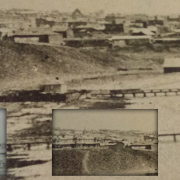Eastern Beach’s Singapore House … on the record
SINGAPORE, 1862: It’s grainy, indistinct and blurry – about what you’d expect from a photo of a structure snapped off in 1862. But it’s startling nonetheless.
What you see, from a distance, is a long, double-storeyed structure, its ground floor well shaded by a deep verandah, overlooking a precipitous cliff with a rude goat-track path leading down its sharp face.
A rough pencil sketch from the same era shows in greater detail, if not greater accuracy, the same building, presumably a few years earlier for it lacks the distinctive verandah.
But the twin jetties reaching out into Corio Bay at the base of the cliff in front of the building leave no doubt it’s the same structure. A short-lived condominium which for a while was clearly among the best property Geelong hosted.
Singapore House, or Singapore Terrace, on what is today Eastern Beach Road, near the corner of Swanston Street, was a complex of nine adjoining buildings inhabited by more than 70 residents in what was described as “a respectable sphere of life”.
It’s fair to assume they were people of means and that developer Alexander Fyfe’s housing project, built in 1855 of timber imported from the Far East, turned him a reasonable profit.
Looking out to the water, the You Yangs and on a clear day to Mount Macedon and the Dandenongs, the building had the best view in town. This was long before peppercorns, cypresses or any other trees blocked the vista.
In fact, it wasn’t far removed from when Aboriginal humpies adorned what is now the entry to neighbouring Eastern Park at the end of Corio Street, then a roughhouse waterfront thoroughfare of stores, pubs and brothels.
In at least one of those pubs, the public bar counter doubled up as a coroner’s autopsy slab when the need arose. Bottoms up, as they say.
For many years, but now long forgotten, Singapore House was remembered as scene of the greatest and worst fire Geelong ever saw. A little like Black Friday of 1939 if you like: wicked but consigned to a history largely beyond living memory.
Looking over old pictures at The Geelong Club a while back, I tripped to the pencil sketch of the Corio Bay waterfront from Eastern Beach to Moorabool. It’s undated but I’m guessing it’s somewhere around the original club’s inception in 1859.
The sketch features names for the various buildings it depicts. Not unlike another famous picture of early Geelong’s waterfront, painted by Wilbraham Liardet from the Western Beach aspect.
It points out Corio Villa, Dr Day’s house, police quarters, pilot houses, Fyfe House, a stone wall, Bayview House — now the derelict Ritz Flats — the Volum Brewery and Macks Hotel.
Front and centre of this simple tableau, however, near the corner of Swanston and The Esplanade, is the extraordinary structure of double-story timber terrace houses.
Now I’ve tracked down a photograph. The only photograph as far as I can ascertain.
It was commissioned in 1862 by the Geelong council and features, hard and high left, in a scene of waterfront Geelong snapped from Eastern Beach. It must have been taken just weeks, perhaps days, before it went up in flames on March 18.
Welcome to Singapore Terrace.
Hope your insurance is paid up, though. For within just seven years, in March 1862, “the greatest ornament of the Esplanade overlooking the Eastern Beach” was burned to the ground.
It was a waterfront inferno to match any New Year’s Eve fireworks since, maybe even the clipper Lightning’s conflagration on the bay a few years later in 1869.
The fire started between floors and, fanned by a strong, hot north-north-westerly, proceeded to demolish the buildings, leaving all its occupants homeless.
Reports said the saddest sight was the “throng of bewildered and terrified women and children rushing from the houses”. Some were appalled at the enormity of the threat facing them, one was overjoyed at evacuating her “little ones scatheless”.
Residents and bystanders watched on, gobsmacked at the furious afternoon spectacle and the firefighting industry battling to contain the blaze. Fire brigades from Geelong, Newtown and Chilwell and their engines, buckets, hoses 60 metres up from the beach couldn’t stop the blaze from turning the resinous timber the terraces were built of from turning white hot and collapsing.
Lucky thing was no-one died in the fire. No so lucky were domestic pets — presumably dogs, cats and budgies — and chickens. Oh, and evidently, someone’s pet monkey expired as well.
Oddly enough, however, rodents that had been plaguing the area cleared out a day or two before the fire. A case, as the Irish firebrand Flann O’Brien might have noted, of rats leaving a sinking chimp.

